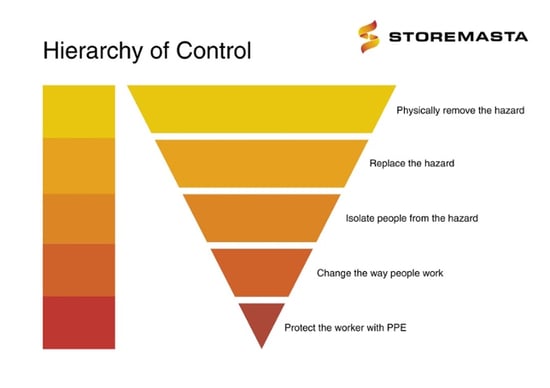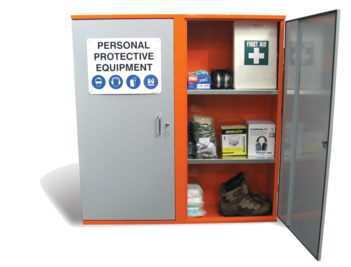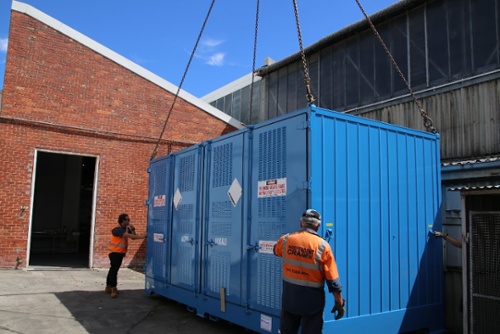As equipment, processes and devices in the workplace, risk controls for chemical hazards are an essential step in the risk management process. When personnel are determining which actions to take when hazards are identified, the implementation of the correct risk control is a key factor in ensuring safety and WHS compliance. Your control measure will help you to minimise the likelihood or impact of a chemical hazard, so you can create a safer workplace for your staff and community. But what are the risk controls that you can immediately implement to improve occupational safety in your business?
Reduce the Risk
To reduce the risk of dangerous goods or hazardous chemicals, a risk assessment is required. This risk assessment should be performed by experienced and qualified staff (or professional Dangerous Goods Consultants) who have the knowledge of chemical hazards, as well as the compliance obligations that your site will need to adhere to. Without a thorough and accurate risk control, you won't be able to move on to determining the control measure or measures that will need to be put in place.
IMPORTANT: To learn more about the risk assessment process, you can read our popular post 3 Types of Risk Assessments for Minimising Chemical Risks and Hazards.
Why is Risk Elimination the Most Preferred Option?
If you look at any type of chemical hazard — whether it's a fire risk or the potential for a toxic chemical leak — the most preferred control measure is to completely eliminate the problem.
Risk elimination is the most effective control as this method will remove the chemical product from your site, so you won't have to control it.
The Hierarchy of Controls is the process that identifies the most effective controls through to the least effective control.

As a model that assists in the control of workplace hazards, the Hierarchy of Controls gives us a solid framework to determine how to control each chemical hazard onsite.
This hierarchy works by placing elimination at the top of the controls, and personal protective equipment (PPE) at the bottom of the controls - with the measures listed in order of effectiveness.
Risk control measures as per the Hierarchy of Controls are:
- Elimination
- Substitution
- Engineering Controls
- Administrative Controls
- Personal Protective Equipment (PPE)
Eliminate Hazards and Risks
While you can eliminate hazardous chemicals or dangerous goods from your workplace, it is often not practical to do so. Many industries rely on these goods to operate their worksites, with non-hazardous options not viable in terms of productivity or effectiveness.
To eliminate a risk, you must either completely get rid of the chemical involved - or stop using the equipment, tools or work processes that help to create the hazard.
IMPORTANT: Learn more about elimination, and other controls, by reading our post Eliminating Vs Substituting Chemical Hazards from Your Workplace.
Substitute Chemical Hazard
Substitution in the Hierarchy of Controls is the next step when elimination (ie. physically removing the hazard) is not deemed possible.
Instead of getting rid of the chemical hazard by changing the way your site operates, you may be able to substitute your hazardous chemical for a safer alternative. However, substitution must be closely monitored in case any new hazards are introduced to your site.
For example, while petrol may produce a fire or explosion risk, it is one of the most cost-effective forms of fuel. It may not be practical to choose battery-powered vehicles - and the introduction of these may also introduce a new risk (ie. lithium-ion battery hazards).
REMEMBER: Risk controls begin with an accurate risk assessment. Make your next risk assessment a simpler task by accessing your FREE chemical risk assessment template pack.
The Importance of Risk Control Measures in the Workplace
Due to the difficulty with elimination and substitution, engineering controls are often a key control measure to reduce risk.
Engineering controls, such as outdoor chemical storage, are designed to isolate your workers from the hazard.
Engineering Controls for Chemical Hazards
Engineering controls are designed to isolate staff, supervisors and contractors from the chemical hazard, so that harmful effects are controlled.
Some examples of engineering controls that we highly recommend include:
- Spill bunding - isolating workers from chemical leaks and spills by providing liquid-tight containment in the form of bunded shelves, steel bunds, portable bunds, IBC bunds and drum bunds
- Floor bunding - bunding for floors of factories, warehouses and manufacturing facilities, to prohibit the spread of chemicals in the event of an accidental release
- Indoor safety cabinets - the storage of your hazardous chemicals and dangerous goods must protect workers from a range of hazards, including vapours and spills. Compliant safety cabinets offer excellent isolation from the contents, through design features such as sequentially closing, close-fitting doors and spill sumps.
- Outdoor chemical storage - outdoor storage of hazardous chemicals requires a range of select controls to minimise the likelihood and impact of hazards. These include high security to prevent unauthorised entry to the store, natural ventilation and impact protection.
- Handling and dispensing equipment - chemicals can cause harm to people, property and the environment when they're being transported, stored or handled. In addition to this, when packages are being moved around the worksite, decanted or dispensed, the risk of an accidental release is increased. Using the correct handling and dispensing equipment, such as gas bottle trolleys or drum dollies, can protect staff when they're carrying out their everyday duties.
- Temperature controlled storage – some chemicals must be kept in conditions that are within a specific temperature range. Without the correct conditions for storage, these chemicals may create a chemical hazard. Temperature controlled stores operate as climate controlled environments, where dangerous goods can be stored in the safest way possible.
Administrative Controls
To bolster the performance of your engineering and isolation controls, it’s important to also consider all the procedures and policies that can improve safety at your site.
Administrative controls are the fourth step in the Hierarchy of Controls — allowing procedures and processes to be examined and altered to improve chemical safety.
These administrative controls for chemical safety may include changes to:
- Staff training to improve chemical hazard knowledge and safety
- Procedures for housekeeping duties
- Procedures for engineering control maintenance
- Standard operating procedures for the use of engineering controls
- Chemical inventory controls and ordering processes
- Implementing security measures to ensure authorised entry to trained personnel only
- Emergency response plans and training
REMEMBER: Administration controls assist in reducing harm and minimising exposure to chemical hazards. They can improve the health and safety of your workplace, through the control of administrative processes and the bolstering of onsite training and awareness of hazards.
Personal Protective Equipment
As we touched on earlier, personal protective equipment (PPE) is the last tier of the Hierarchy of Controls. As it’s considered the least effective control method, you must first attempt to eliminate and substitute the hazard, before moving on to control the risk through engineering controls and administrative controls.
However, that doesn’t mean that personal protective equipment isn’t essential for worker health and safety, as well as a crucial factor in WHS compliance.
Selecting and maintaining the correct PPE for your onsite chemicals is a key responsibility of organisations who carry any type of hazardous chemicals.
To reduce the risk using personal protective equipment (PPE), you must refer to your safety data sheet for each chemical product that you hold. As each chemical will have it’s own set of hazards, the PPE must be tailored to suit the requirements of the hazardous product.
 Having dedicated storage for your personal protective equipment can assist with increasing safety and compliance for operations dealing with dangerous goods.
Having dedicated storage for your personal protective equipment can assist with increasing safety and compliance for operations dealing with dangerous goods.
Cleaning, maintaining and replacing the personal protective equipment is also an ongoing obligation for workplaces. Staff must be able to safely put on and take off the equipment, to reduce the likelihood of contact with the substance. The equipment must then be properly cleaned, decontaminated and inspected to ensure that there are no necessary repairs or problems with the PPE.
What Risk Controls are You Using in Your Business?
In an ideal situation, workplaces would be able to properly identify and assess chemical hazards and risks, while using the Hierarchy of controls as a systematic methodology for controlling these risks. In doing so, the health and safety of your workers would be protected, as would the surrounding natural environment (soil, waterways, wildlife) and community.
However, it’s not always easy determining how you will start controlling the key risks that you identify in your workplace. To make this process a little simpler, we’ve developed a handy eBook that outlines your basic obligations and some of the most popular engineering controls. The Ultimate DG Storage Handbook will take you through these considerations and offer expert advice on storage, handling and emergency decontamination equipment, so you can achieve compliance. Get your copy today for just $6.99 + GST. It’s a little price to pay to improve safety at your site.
Talarah has been working for Storemasta for many years, specialising in Marketing, Customer Service and Risk Management Solutions.


